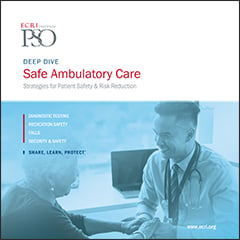When technology entered healthcare, so too did alerts. Alerts acted as attention grabbers, reminders, notices of changes in a patient's condition, and warnings about malfunctions or improper functioning. As technology grew more prevalent with the advent of automated dispensing cabinets, computerized provider order entry (CPOE), digital point-of-care monitors and devices, and electronic health records (EHRs), the number of alerts grew exponentially. Clinicians were exposed not only to their own patients' alerts, but to all of the alerts or alarms sounding within a particular unit. The number of per-patient alerts can be astounding. One facility determined that in its critical care unit, "between 150 to 400 physiologic monitoring alarms" sounded per patient, per day.1 This cacophony is compounded by alerts triggered by electronic records.
Robert Giannini, NHA, CHTS-IM/CP, Patient Safety Analyst and Consultant, ECRI
Recent Posts
Reducing the Noise from Alerts, Alarms, and Notifications
Topics: Patient Safety, Partnership for Health IT
Four Ways to Say No to Adverse Drug Reactions
The seeds of an adverse drug interaction can be planted at any point in the care process, by any of the individuals involved. For instance, take a look at these common scenarios:
- A clinician, overwhelmed by meaningless alerts, overrides a warning and misses crucial information about a patient's drug allergy.
- A physician office's electronic health record (EHR) system enters the correct drug allergy information, but the pharmacist is unaware of the information.
- A young adult patient is allergic to an antibiotic, but doesn't know exactly what happened when he took the antibiotic as a child and he doesn't mention it when being treated for pneumonia.
The chances that any one of these situations may occur is increasing.
Topics: Patient Safety, Partnership for Health IT
Diagnosing Communication Gaps in Diagnostic Test Reporting
In the United States, there are 30 times more outpatient visits as hospital discharges. As a result of the high volumes and complexities inherent to ambulatory settings, one in twenty patients can expect to experience a diagnostic error in their lifetime. According to the Agency for Healthcare Research and Quality, 55 percent of patients said that diagnostic errors were a chief concern to them.
Earlier this fall, ECRI Institute Patient Safety Organization took an in-depth look at patient safety events in ambulatory care, specifically physician practices and healthcare clinics. Nearly half of the 4,355 analyzed events were related to diagnostic testing. Errors that occur during diagnostic testing can have potentially devastating consequences for patients. The majority of these events occurred after tests had taken place, often due to a gap in communication.
Topics: Aging and Ambulatory Care



